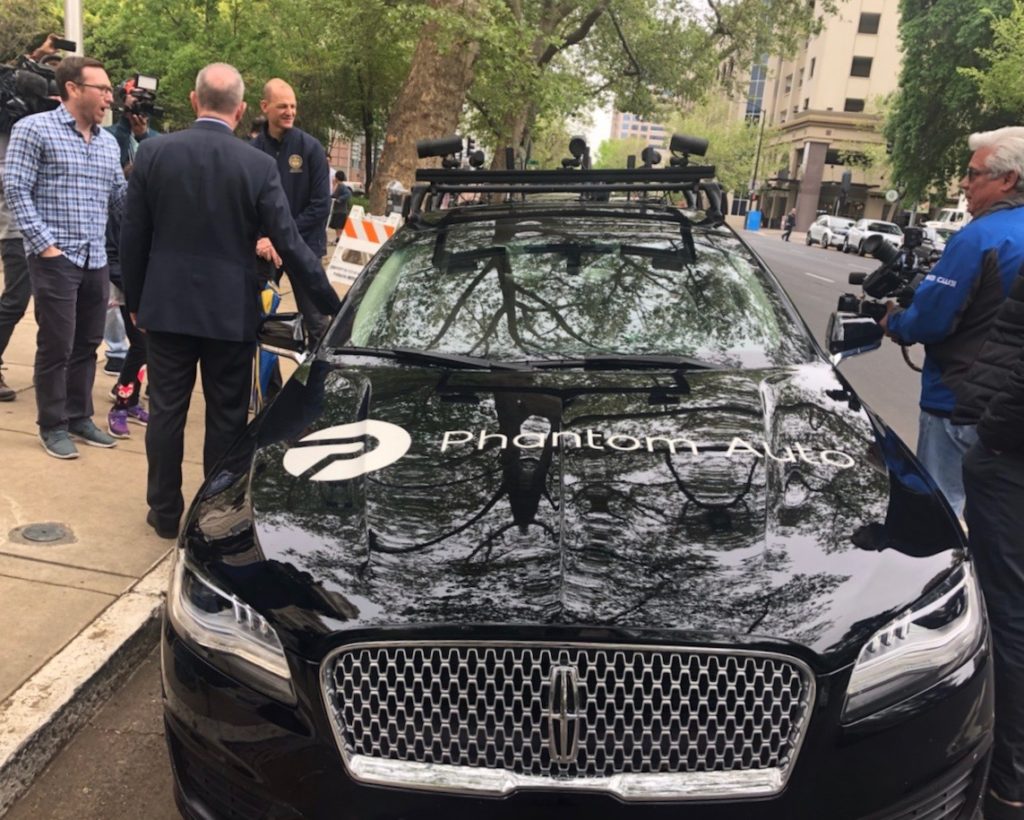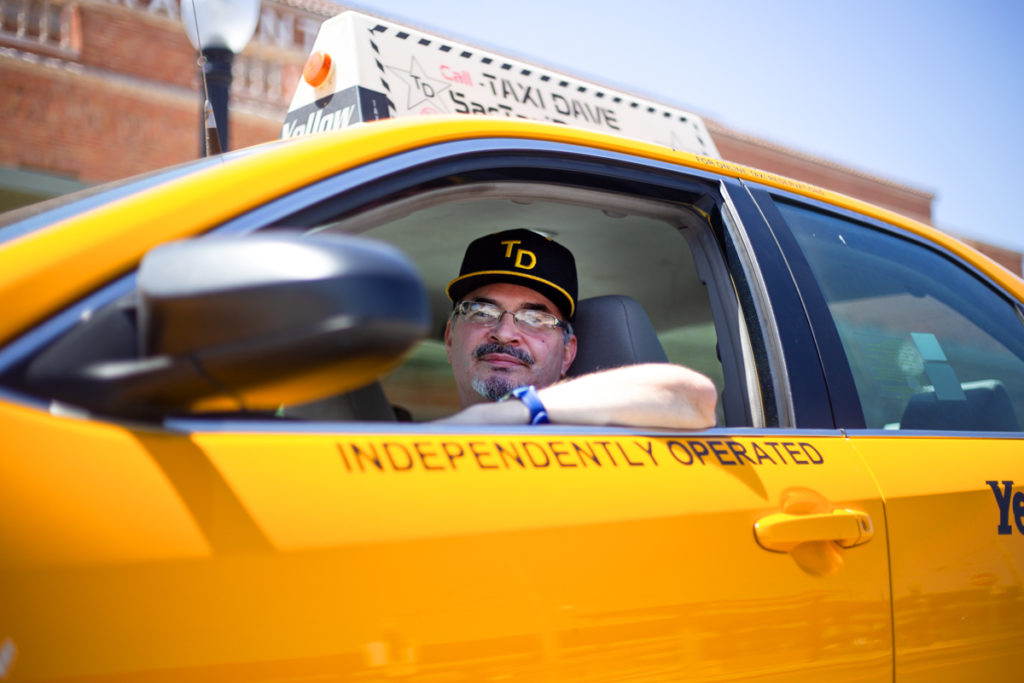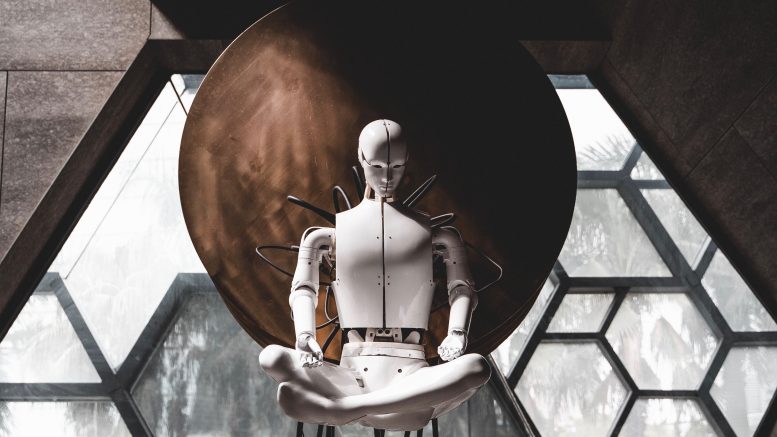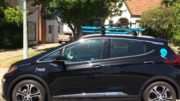Sacramento boosts automated cars, but what happens to professional drivers?
By Scott Thomas Anderson
Sacramento Mayor Darrell Steinberg leaned out from the window of a dark sedan and gave a long wave to the photographers huddled around its strangely fitted rooftop. “To the future,” he called out. Then the vehicle slowly pulled away.
Depending on one’s perspective, Steinberg was either steering his city toward a new economic horizon, or he was cheerfully waving from an ominous piece of job-killing technology—tech the mayor is taking an active role in promoting and advancing in a city that has done little to plan for the alarming employment disruption it could cause.
According to the Sacramento County Department of Economic Development, there are 18,000 local professionals who earn their living behind the wheel of cabs, long-haul trucks, shuttle buses and delivery vehicles. The limited data on Uber and Lyft suggests there are hundreds more Sacramantans paying their bills through the city’s ride-share economy. But these are all members of the working class who could be looking at very different streetscapes—and very different job prospects—in the near future.
In August 2018, the city of Sacramento entered into a partnership with Phantom Auto, a Mountain View company specializing in autonomous vehicle safety. Officials allowed Phantom Auto to spend six months “testing and mapping the city’s wireless capacity and coverage at the street level” to pave the way for avenues buzzing with driverless cars.
City leaders were not only giving Phantom Auto exclusive access to Sacramento’s infrastructure, they were also paying for the privilege to the tune of $100,000, according to a report from Wired.
So why would a city give public funds to a Silicon Valley corporation already fat with millions in venture capital to be part of an experiment? Louis Stewart, Sacramento’s first chief innovation officer, said City Hall wants to “accelerate the time to market for autonomous vehicles.”
Steinberg’s big wave from Phantom Auto’s semi-autonomous car April 15 was partly the result of the helping hand his administration lent to phase in the company’s testing stage. The mayor is betting big on predictions from research firms such as Strategic Analytics, which forecast an eventual $7 trillion “passenger economy” emerging across the globe from automated vehicles.
But other experts warn that before the financial boon comes, massive job loss and social pain come first.
A 2018 study by the research firm Bain & Company found that automation will eliminate as many as 20 to 25 percent of current American jobs by 2030. A similar analysis by the Center for Global Policy Solutions determined driverless cars will be the earliest force in that upheaval. The authors of Global Policy’s report wrote that any rapid shift to automated vehicles will cost “a significant source of work for those with lower levels of educational obtainment.”
In other words, wave goodbye to a lot of livable and semi-livable wages that residents of Sacramento can make without a college degree.
Steinberg canceled an interview for this story, but later issued a statement to SN&R: “As a city, we can’t run from automation. We have to participate in the new economy while making it work for all of our people. That goal was at the heart of our campaign for Measure U. Studies show that automation won’t just eliminate jobs; it will create many more jobs, but these will require higher levels of education and skill. Our responsibility is to make sure our residents are ready to take those jobs. That’s why youth and workforce training will be a major focus for my office as we develop plans for spending the new resources generated by voter approval of Measure U.”
Speaking at the California Innovation Summit in January, he stressed that the city must seek the jobs of the future. “We are rapidly changing as a city,” the mayor said. “We’re going from a traditional capital city and government town to an aspiration to be the center of technology.”
Steinberg added that being “on the cutting-edge of transportation” would be especially good for disabled residents and families in low-income neighborhoods.
Edward Escobar, founder of #DriversUnite, a campaign to protect both professional and gig drivers, says the kind of deal Sacramento officials struck with Phantom Auto mirrors a trend that happening in other cities. And, he adds, it’s dangerous when elected officials and regulators cozy up to driverless vehicle companies without talking about the impending job loss.
“They have tunnel vision all the way,” Escobar says. “They’re buying into this utopic sales pitch from companies who’ve convinced them that they’ll provide some magic bullet. These public officials may want to be known for ushering in a new era of transportation, but the problem is, the primary motivation for the companies who are convincing them is a hundred-percent profit-driven, and officials are going along with that and forgetting the public trust.”
Commitment at all costs

In spring 2018, one of Uber’s driverless SUVs struck and killed a woman as she crossed the road in Tempe, Arizona. In a matter of weeks, Uber arrived at a financial settlement with Elaine Herzberg’s family and CEO Dara Khosrowshahi was on the Today show saying his company remained “absolutely committed to self-driving cars.” Khosrowshahi couched this pledge, ironically perhaps, as part of Uber’s hope for safer roadways.
But investors see more truth in the words of Khosrowshahi’s predecessor, Travis Kalanick, who acknowledged two years earlier that driverless cars were “basically essential” to his company finally making a profit.
For these and similar tech companies, it may be a case of desperation driving innovation. A report by TechCruch found Uber has already spent more than $900 million on developing its driverless car fleet.
That’s not surprising since Uber and rival Lyft continue to lose money under their business model with human drivers. Thousands of them in at least eight cities went on strike Wednesday to protest wages and working conditions.
Lyft went public in March and, a month later, was already being sued by investors for inflating its value. Uber, which plans its initial public offering this week, secured a $1 billion investment in its self-driving unit after reporting a $3 billion operating loss last year. Both ride-share giants are betting their futures on driverless cars.
Unlike Uber and Lyft, many traditional sectors of the driving industry are still lucrative and still supporting long-term employment. The research firm Sageworks found profit margins for long-haul trucking doubled between 2017 and 2018, and they’re projected to rise again this year. Drivers working for delivery services UPS or FedEx also saw their employers’ profits fatten. Likewise, overall revenues for limousine services and the charter bus industry remain strong.
In Sacramento County, the mainstream driving industry breaks down to some 5,668 drivers working for companies such as UPS and FedEx or the U.S. Postal Service, while some 5,730 drivers work for ground transportation services or the charter bus industry, according to the economic development department. It also reports there are some 4,879 long-haul and pipe transport truck drivers living in the Sacramento area, earning between $52,000 to $99,000-a-year.
These may be functioning corners of the region’s workforce, but they are under threat from automated vehicles: A 2017 report from the Center for Global Policy Solutions found that 4 million American driving jobs are in near-term peril from driverless cars.
And since that report’s release, the development of automated driving tech has been burning rubber.
At the end of April, Tesla CEO Elon Musk announced that his company’s robo-taxis would be on the road by next year to compete with Uber and Lyft (though the prediction was made just days after it was revealed that Tesla’s autopilot could be tricked into driving at oncoming traffic by placing small stickers on roadside signs). Nonetheless, Musk’s confidence reflects the reality that global investors have recently put more than $4.2 billion into research and development for automated vehicle tech, all in a bid to eventually phase out traditional driving roles.
Wayne Campbell is a long-haul trucker who hosts a popular Facebook Live show called “In the Driver’s Seat.” Campbell, who is “trucker famous” around the diners and rest stops along Interstate 5 and Highway 99 in Sacramento, says he speaks daily with truckers from Northern California and is convinced they won’t be getting the “next-generation” jobs that politicians like Steinberg keep bragging about when justifying hopes for a brave new passenger economy.
“When [public officials] talk about the new jobs, they’re not talking about the men and women in the trucking industry, who aren’t generally big on computers,” Campbell says. “They keep talking about these possibilities, but they’re not talking about our family heritage drivers, our bloodline drivers, our people who did this job because it was supposed to be good for this country.”
“They never want to bring up what this [transition] means for men and women in the real world who will have to retrain themselves,” he added. “For someone like that, where do they even start?”
That question was never broached in the city of Sacramento’s press release about its partnership with Phantom Auto. What is clear is that, in the midst of a driverless car investment windfall across Silicon Valley, Phantom Auto also received public funds. Likely of more value to the Mountain View company was the open access officials gave it to public infrastructure for testing.
So what does Sacramento get out of this huge assist to a company that’s part of an industry movement that could eventually cost hundreds of local workers their jobs?
When the Phantom Auto deal was announced, Steinberg said it would put Sacramento on the map with the emerging titans of tech. “We are creating a testing ground for such technologies that will ensure our status as a hub for the jobs they create,” he said in a statement.
City Hall echoed that point again on May 1, when it released a video on Twitter in which Stewart said that Sacramento “is taking the lead on mobility innovation, by bringing technology solution companies to Sacramento and testing them out.”
On a parallel track, the city is also aggressively seeking to become a research center and proving ground for electric cars, using $44 million it received in a settlement from the Volkswagen emissions cheating scandal. Plans include electric shuttle buses, ultra-fast public charging stations and electric car sharing services, including one run by AAA Northern California that launched last week with 260 Chevy Bolts.
In the video, with highly produced images of Phantom Auto cars and other driverless vehicles whizzing around local streets, Stewart added, “That means new solutions that you may have never seen before.”
As with previous speeches and press releases, the video made no mention of local job loss.
Blind spots

Dave Rivera might be the best-known taxi driver in Sacramento. Working under the umbrella of Yellow Cab services, he has a popular YouTube channel where he spins cabbie rhymes and touts tourist attractions around the Capital City.
Rivera isn’t falling out of his driver’s seat at news the mayor and other Sacramento officials are giving subsidies to Phantom Auto. That’s because he believes that City Hall has always lent inappropriate support to two of the main players in the driverless cars quest, Uber and Lyft.
Rivera says he repeatedly brought concerns to Sacramento officials that the ride-share giants were operating as illegal taxi services and was soundly ignored. Then, in April 2018, the California State Supreme Court unanimously ruled that delivery company Dynamex Operations West—which has a similar business model as Uber and Lyft—was illegally misclassifying drivers as contract workers when they’re actually employees under state law.
In January, labor attorney Shannon Liss-Riordan, who’s suing Uber and Lyft, told SN&R the ride-share giants have attorneys engaged in stalling tactics to try to prevent the ruling from going into effect.
Rivera says the Dymamex ruling vindicates everything he tried to warn City Hall about. He said Steinberg and the council had enough legislative experience and common sense to know Uber and Lyft weren’t following the law. It is an example, Rivera says, of how enamored city officials are with pleasing—and building political alliances with—big tech.
“It doesn’t surprise me they’re doing this,” Rivera said of the subsidies to Phantom Auto. “The city already spent money supporting ride-share companies, which were illegal, by putting up signs around Midtown that flagged parking areas for them.”
As for the competition that robo-taxis would bring to his own business, Rivera says he isn’t worried. That’s because of a nasty little streak in human nature he’s seen over the last decade, one he thinks tech leaders just don’t understand: Passengers, especially at night, can be extremely disgusting. Drunks vomit and urinate in the seats—or worse.
Rivera says that never happens in his cab because he’s vigilant and knows how to handle the ultra-inebriated. But without a human driver watching, look out. “Every bad thing you’ve seen on the light rail, it’s going to be that inside the car you’re getting into,” he predicted. “The experience is going to be horrible.”
Rivera isn’t the only one forecasting this. At a public debate in April about whether driverless cars are good for society, New York University assistant professor Meredith Broussard, who studies the ethics of artificial intelligence, raised numerous questions about safety and sanitation in driverless cars and buses. Rivera is also concerned about the overall safety of passengers.
“They’re fascinated with technology, I get it,” Rivera said of city officials. “But are they going to say health and safety don’t matter anymore? That’s one of their main responsibilities.”
Indeed, in addition to Herzberg’s death, at least three other people have been killed since 2016 while using Tesla’s autopilot technology.
Steinberg has stressed that Phantom Auto’s mission, in particular, is creating a solid safety infrastructure for driverless cars.
But such words ring hollow for advocates such as Escobar, who argue that leaders in Sacramento and San Francisco are racing forward with promoting technologies they simply don’t understand.
“They look at all the good and they’re not focused on the impacts and consequences,” Escobar said. “It’s a rush to judgment without fully evaluating all the sources. I don’t think they’ve done their homework.”
He said that #DriversUnite is fighting to make sure elected officials start planning now for safety, job losses and employment disruption caused by automated vehicles.
“You discuss it now and help shape it as it’s rolling out,” he stressed. “If you wait to respond when it’s here, it will be too late.”



I found this to be one of the most poorly written stories to appear in the News and Review. It is so slanted and biased that it is sad. It treats the creation of driverless cars as a zero-sum game for both taxi drivers as well as Uber/Lyft drivers, etc. This is far from the truth. The reality will be like it is now—a mixture of modes for personal alternative transportation. Also, those who are drivers now who may be affected will have options to do other sorts of work. Economies, jobs, life—all change over time. This article mirrors the idea that cars replacing horse-drawn carriages will unemploy carriage makers so we shouldn’t allow cars to exist; we shouldn’t have automated telephone exchanges because we will unemploy switchboard operators, etc. Poor job even by News & Review standards.